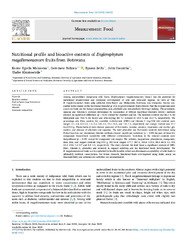Nutritional profile and bioactive contents of Englerophytum magalismontanum fruits from Botswana
Date
2025Author
Mokwena, Kaone Kgotla
Bultosa, Geremew
Seifu, Eyassu
Gwamba, John
Khumoetsile, Thabo
Metadata
Show full item recordAbstract
Among underutilized indigenous wild fruits, Englerophytum magalismontanum (Sond.) has the potential for nutritional improvement and economic development of arid and semi-arid regions. In view of this, E. magalismontanum fruits pulp collected from Kanye and Molepolole, Botswana was evaluated. Survey conducted to document on the traditional knowledge of E. magalismontanum fruits showed that the respondents were aware on fruits use for human consumption, jam, alcoholic and non-alcoholic beverage making. The proximate, mineral and vitamin C contents determined by Association of Official Analytical Chemists (AOAC) methods showed no significant difference (p > 0.05) except for moisture and fat. The moisture content was 66.2 % for Molepolole and 70.6 % for Kanye and after drying (60 °C) reduced to 14.2 % and 16.2 %, respectively. The percentage ash, fiber, protein, fat, available carbohydrate (CHO) and vitamin C (mg/100 mL) contents were ranged 2.1–2.4, 4.9–5.2, 1.4–2.2, 2.0–3.5, 70.1–74.6, and 7.0–7.3, respectively and energy content was 17.7 kcal/100 g. Phytochemical tests showed presence of flavonoids, tannins, steroids, terpenoids and cardiac glycosides, and absence of alkaloids and saponins. The total phenolics and flavonoids contents determined using Folin-Ciocalteu and aluminium chloride methods showed significant variations (p < 0.05) because of bioactive compounds biosynthesis variability with different environments. Variations in the mineral contents were insignificant (p > 0.05) except for manganese and copper. The calcium, magnesium, phosphorus, manganese, iron, zinc, and copper contents (mg/100 g, db) were ranged 177.7–207.5, 105.6–112.9, 68.9–69.4, 5.1–9.9, 10.3–15.0, 4.2–4.7 and 0.5–1.1, respectively. The study showed the fruit bears a significant content of CHO, fiber, vitamin C, phenolics and minerals to support nutrition and for functional foods development. The E. magalismontanum fruits can be exploited for health benefits which can illuminate acceptability of wild fruits to ultimately motivate conservation. For future research, functional foods development using fruits, assays on bioavailability and antioxidants activities are recommended.
Collections
- Reseach articles [146]

